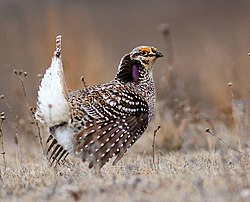Sharp-tailed grouse
| Sharp-tailed grouse | |
|---|---|
 |
|
| Scientific classification | |
| Kingdom: | Animalia |
| Phylum: | Chordata |
| Class: | Aves |
| Order: | Galliformes |
| Family: | Phasianidae |
| Subfamily: | Tetraoninae |
| Genus: | Tympanuchus |
| Species: | T. phasianellus |
| Binomial name | |
|
Tympanuchus phasianellus (Linnaeus, 1758) |
|
| Synonyms | |
|
|
The sharp-tailed grouse (Tympanuchus phasianellus) (previously: Tetrao phasianellus), is a medium-sized prairie grouse. It is also known as the sharptail, and is known as fire grouse or fire bird by Native American Indians due to their reliance on brush fires to keep their habitat open. The Sharp-Tailed Grouse is the provincial bird of Saskatchewan.
The greater prairie-chicken, lesser prairie-chicken, and sharp-tailed grouse make up the genus Tympanuchus, a genus of grouse found only in North America. The full scientific name of the sharp-tailed grouse is Tympanuchus phasianellus. Six extant and one extinct subspecies of sharp-tailed grouse have been described:
Adults have a relatively short tail with the two central (deck) feathers being square-tipped and somewhat longer than their lighter, outer tail feathers giving the bird its distinctive name. The plumage is mottled dark and light browns against a white background, they are lighter on the underparts with a white belly uniformly covered in faint "V"-shaped markings. These markings distinguish sharp-tailed grouse from lesser and greater prairie chickens which are heavily barred on their underparts(Connelly et al. 1998). Adult males have a yellow comb over their eyes and a violet display patch on their neck. This display patch is another distinguishing characteristic from prairie chickens as male prairie chickens have yellow or orange colored air sacs(Connelly et al. 1998). The female is smaller than the male and can be distinguished by the regular horizontal markings across the deck feathers as opposed to the irregular markings on the males deck feathers which run parallel to the feather shaft. Females also tend to have less obvious combs. Males weigh an average of 33.5 oz (951 g) and females average 29 oz (815 g).
Sharp-tailed grouse historically occupied eight Canadian provinces and 21 U.S. states pre-European settlement (Johnsgard 2002). They ranged from as far north as Alaska, south to California and New Mexico, and east to Quebec, Canada (Johnsgard 2002). Following European settlement the sharp-tailed grouse has been extirpated from California, Kansas, Illinois, Iowa, Nevada, and New Mexico, (Johnsgard 1973; Connelly et al. 1998).
These birds forage on the ground in summer, in trees in winter. They eat seeds, buds, berries, forbs, and leaves, also insects, especially grasshoppers, in summer.
...
Wikipedia

